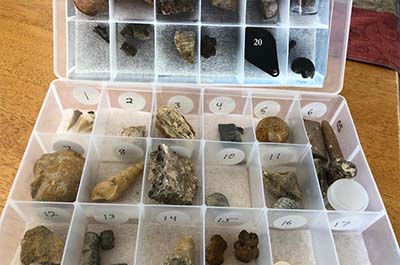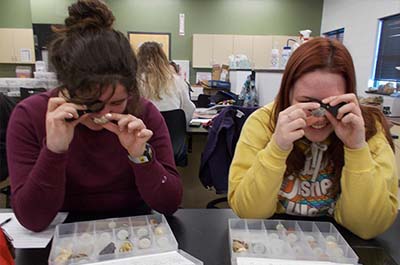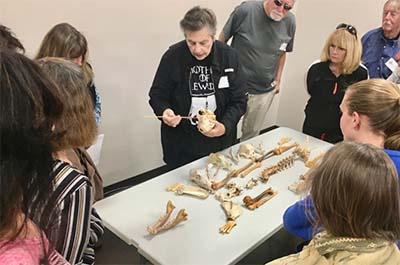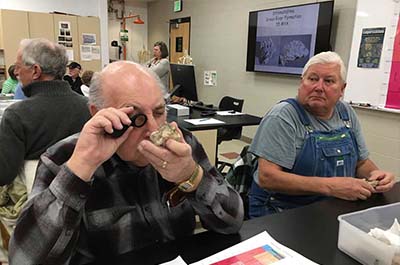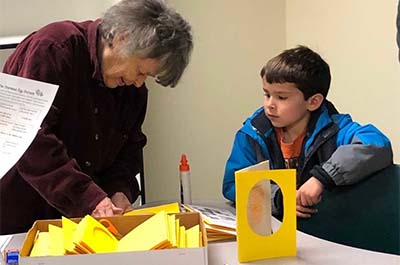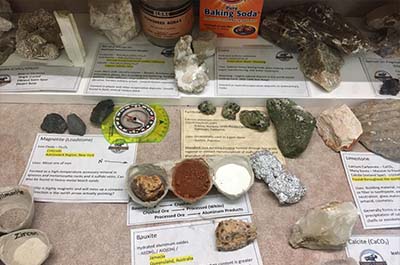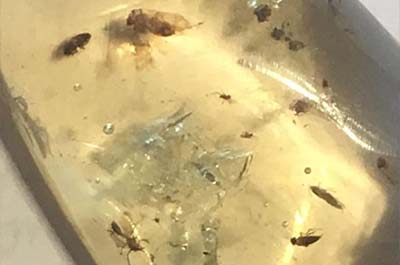Skeletons – The Story is in the Bones
Understanding Animals through Anatomy
HOW CAN YOU
Tell the age of a skeleton?
Tell the difference between a domestic dog and a coyote or a wolf?
Tell whether an animal relied primarily on the sense of sight, smell or hearing from just looking at the skull?
Scroll to bottom of the page for answers!
Members of our community were treated to an introduction in osteology and the story of the lives of animals that is recorded in their bones.
An animal’s bones tell us vast amounts of information about that animal’s life: its skills, behavior, diseases, diet, whether it was predator or prey. Pathology provides information about any deviation from a healthy, normal condition, e.g. if the animal had broken limbs which healed while it was still alive.
Dr. Sue Ware, forensic paleontologist and Research Associate with the Denver Museum of Nature & Science, presented “Skeleton Crew: Learning About Animal Bones and What They Do” at the Royal Gorge Dinosaur Experience on May 12, 2018.
Beginning with a mystery skull hidden in a pillowcase, participants felt the delicate skulls for tiny details which might help them identify the animal – were the teeth sharp or dull, how long was the snout, how big was the skull, was their a ridge on the top of the skull (sagittal crest). More common animals such as a coyote, wolf, gorilla, and house cat were easier to identify than the anteater and pronghorn. Through this exercise, students tuned their senses. Sue then taught easy identification techniques, such as noticing that members of the mustelid family (badgers, wolverines, weasels) have a post orbital constriction next to a triangular shaped back-of-the-skull.
Following a Power Point walking students through the function of various bones in the body and instruction on how to read these bones, time for the final exam arrived: sheets were removed revealing a jumble of bones on six different tables. Each group worked together to reassemble the mix of vertebrae, ribs, limb bones, phalanges, and the odd bones including the sternum and scapulas, and in the process students unveiled a big horn sheep, coyote, bobcat, pronghorn, cougar and wolf.
Sue’s ability to interweave detailed information about anatomy with stories and fascinating facts made for an easy-learning experience. Laughter accompanied note-taking.
Sue is also a paleopathologist at the George C. Page Museum of La Brea Discoveries (now known as the Tar Pit Museum) in Los Angeles, and a contributor to the Wolfe Recovery Project at Yellowstone National Park. She studies the osteology, diseases, causes of death, and general health of the wolves by analyzing their carcasses for pathology and its impact on the life and behavior of individual wolves and pack dynamics since their reintroduction in 1995-1996.
Sue also works with the Heritage and Research Center in Gardiner, Montana, where the results of her research and the skulls are housed.
Fremont Stones ‘n Bones sponsored this class, and would like to thank the Royal Gorge Dinosaur Experience for generously providing a perfect setting and the Denver Museum of Nature & Science Zoology Department for allowing access to the specimens in its collections.
HOW CAN YOU
Tell the age of a skeleton? Answer: Certain sutures (those zig zag lines between the various plates of the skull) close (fuse) at certain stages in life.
Tell the difference between a domestic dog and a coyote or a wolf? Answer: The angle from the forehead to the snout is much steeper on a domestic dog.
Tell whether an animal relied primarily on the sense of sight, smell or hearing from just looking at the skull? Answer: Check out the size of the eye orbits, the length of the snout and the complexity of turbinates within, and the auditory bullae on the underside of the skull. A more developed sense structure indicates more reliance on that skill.
More Articles from “Stones ‘n’ Bones Activities”
Fossil Boot Camp – Covid Style
Stones ‘n Bones of Fremont County traditionally presents two or three Fossil Boot Camp classes each year for school age students and adults. With COVID, that has proven a little difficult
Fossil Boot Camp for PCC Historical Geology Students
Fremont Stones ‘n Bones introduced 16 Pueblo Community College students to fossils in Steve Wolfe’s Historical Geology class.
Stones ‘n’ Bones With Villa Bella School’s 2nd Graders
“What do paleontologists do?” is the question we were asked to help answer for 50 second graders at Pueblo, Colorado’s newest elementary school on January 16, 2020.
The Close Relationship Between Man & Dog
Dr. Sue Ware returned to the Royal Gorge Dinosaur Experience for the second time, to the delight of 27 community members. She presented a program entitled “From your Campfire to your Bed: The Evolution, Importance & Relationship between Dogs and Humans”.
Fossil Boot Camp at PCC Mini-College
For the 5th straight year, Stones ‘n Bones presented Fossil Boot Camp to 31 senior citizens in the Fremont County community.
Stones ‘n’ Bones & the Enormous Egg
What happens when an entire elementary school reads the same book, The Enormous Egg, and asks Fremont County Stones and Bones to come in to help with the family night to celebrate the reading? A two-hour evening full of paleontology learning!
Introducing Geology Students to Fossils
How does Steve Wolfe, Historical Geology instructor at PCC-Fremont Campus, prepare his students for field season observations? One way is by introducing them to fossils
Identifying Trilobites
The Pioche Formation of eastern Nevada is world famous for its amazing preservation of trilobites. Very old trilobites, from the Lower Cambrian (542 – 521 million years old), almost the oldest on record.
Everything Begins With Mining
There are many ways to appreciate rocks. Many of us notice them simply for their color, texture and shape, irresistible and raw in nature.
Insects Trapped in Amber
Many of us are familiar with the high preservation of insects and leaves in the Green River Formation, a Colorado lagerstätte well known for field trips yielding magnificent fossils.

